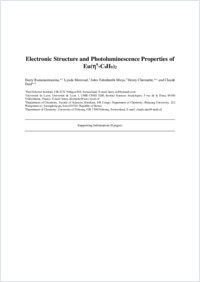Electronic structure and photoluminescence properties of Eu(η9-C9H9)2
- Ramanantoanina, Harry Paul Scherrer Institute, CH-5232 Villigen PSI, Switzerland
- Merzoud, Lynda Institut Sciences Analytiques, Université de Lyon, Université de Lyon 1, UMR CNRS 5280, 5 rue de la Doua, 69100 Villeurbanne, France
- Muya, Jules Tshishimbi Department of Chemistry, Hanyang University, 222 Wangsimni-ro, Seongdong-gu, Seoul 04763, Republic of Korea - Department of Chemistry, Faculty of Sciences, University of Kinshasa, Kinshasa, DR Congo
- Chermette, Henry Institut Sciences Analytiques, Université de Lyon, Université de Lyon 1, UMR CNRS 5280, 5 rue de la Doua, 69100 Villeurbanne, France
- Daul, Claude Department of Chemistry, University of Fribourg, CH-1700 Fribourg, Switzerland
-
09.01.2020
Published in:
- The Journal of Physical Chemistry A. - 2020, vol. 124, no. 1, p. 152–164
English
The electronic structure of Eu2+ compounds results from a complex combination of strongly correlated electrons and relativistic effects as well as weak ligand–field interaction. There is tremendous interest in calculating the electronic structure as nowadays the Eu2+ ion is becoming more and more crucial, for instance, in lighting technologies. Recently, interest in semiempirical methods to qualitatively evaluate the electronic structure and to model the optical spectra has gained popularity, although the theoretical methods strongly rely upon empirical inputs, hindering their prediction capabilities. Besides, ab initio multireference models are computationally heavy and demand very elaborative theoretical background. Herein, application of the ligand– field density functional theory (LFDFT) method that is recently available in the Amsterdam Modeling Suite is shown: (i) to elucidate the electronic structure properties on the basis of the multiplet energy levels of Eu configurations 4f7 and 4f65d1 and (ii) to model the optical spectra quite accurately if compared to the conventional time- dependent density functional theory tool. We present a theoretical study of the molecular Eu(η9-C9H9)2 complex and its underlying photoluminescence properties with respect to the Eu 4f–5d electron transitions. We model the excitation and emission spectra with good agreement with the experiments, opening up the possibility of modeling lanthanides in complex environment like nanomaterials by means of LFDFT at much-reduced computational resources and cost.
- Faculty
- Faculté des sciences et de médecine
- Department
- Département de Chimie
- Language
-
- English
- Classification
- Biological sciences
- License
-
License undefined
- Identifiers
-
- RERO DOC 328174
- DOI 10.1021/acs.jpca.9b09755
- Persistent URL
- https://folia.unifr.ch/unifr/documents/308488
Other files
Statistics
Document views: 116
File downloads:
- pdf: 269
- Supplementary material: 195

